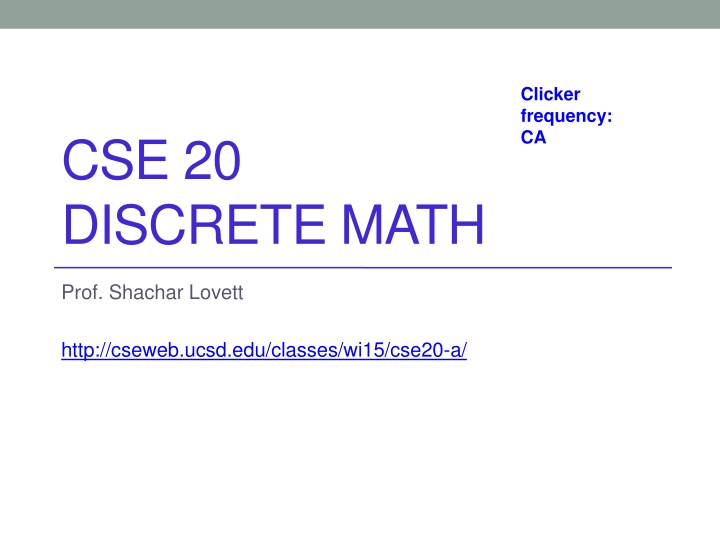
Set Notations and Operations in Discrete Math
Explore set sizes, power sets, unions, intersections, Cartesian products, and important sets of numbers in the realm of Discrete Mathematics, with examples of set builder notation and ways of defining sets. Enhance your knowledge of fundamental concepts in set theory.
Download Presentation

Please find below an Image/Link to download the presentation.
The content on the website is provided AS IS for your information and personal use only. It may not be sold, licensed, or shared on other websites without obtaining consent from the author. If you encounter any issues during the download, it is possible that the publisher has removed the file from their server.
You are allowed to download the files provided on this website for personal or commercial use, subject to the condition that they are used lawfully. All files are the property of their respective owners.
The content on the website is provided AS IS for your information and personal use only. It may not be sold, licensed, or shared on other websites without obtaining consent from the author.
E N D
Presentation Transcript
Clicker frequency: CA CSE 20 DISCRETE MATH Prof. Shachar Lovett http://cseweb.ucsd.edu/classes/wi15/cse20-a/
Todays topics Set sizes Set builder notation Set rapid-fire quiz Section 2.1 in Jenkyns, Stephenson
Power set size Let A be a set of n elements: |A|=n How large is P(A), the power-set of A? A. |P(A)| = n B. |P(A)| = 2n C. |P(A)| = n2 D. |P(A)| = 2n E. None/other/more than one
Union size Recall: ? ? = {?:? ? ? ?} If |A|=n, |B|=m, how large is ? ?? ? ? = ? + ? ? ? = ?? ? ? max(?,?) ? ? min(?,?) E. None/other/more than one A. B. C. D.
Intersection size Recall: ? ? = {?:? ? ? ?} If |A|=n, |B|=m, how large is ? ?? ? ? = ? + ? ? ? = ?? ? ? max(?,?) ? ? min(?,?) E. None/other/more than one A. B. C. D.
Cartesian product size Recall: ? ? = { ?,? :? ?,? ?} If |A|=n, |B|=m, how large is ? ? ? ? ? = ? + ? ? ? = ?? ? ? max(?,?) ? ? min(?,?) E. None/other/more than one A. B. C. D.
Important sets of numbers Z = integers Z = { ,-3,-2,-1,0,1,2,3, } N = natural numbers = positive integers N = {1,2,3, } Q = rational numbers Q = {x/y : x,y Z}
Set builder notation Example: Even integers ? = {? ? ? ?,? = 2?} ? = {? ? | ? ?,? = 2?} : or | pronounced such that n ? ? ?,? = 2?.
Set builder notation How can we write the set of integers that are multiples of 12 ? A. { ? ?,? ?,? = 3? ??? n = 4j} ? ? ?,? = 3? ??? ? ?,n = 4j} B. C. { 36, 24, 12,0,12,24,36 } ? ? ? ?,? = 12?} E. Other/none/more than one D.
Ways of defining a set Enumeration: {1,2,3,4,5,6,7,8,9} + very clear - impractical for large sets Incomplete enumeration (ellipses): {1,2,3, ,98,99,100} + takes up less space, can work for large or infinite sets - not always clear {2 3 5 7 11 13 } What does this mean? What is the next element? Set builder: { n | <some criteria>} + can be used for large or infinite sets, clearly sets forth rules for membership
Primes Enumeration may not be clear: {2 3 5 7 11 13 } How can we write the set Primes using set builder notation? A. {n N : a,b N, n=ab} B. {n N : a,b N, n=ab (a=1 b=1)} C. {a,b N : n N, n=ab (a=n b=n)} D. {n N : a,b N, n=ab (a=1 b=1)} E. None/other/more than one
Russells paradox Let A={S| S S} Does A A? A. Yes B. No C. Neither D. Both E. Other
Russells paradox Let A={S| S S} Does A A? A is not a set, operation is not defined To use set builder notation, we must always define the set as a subset of another defined set, E.g., A={n N : a,b N, n=ab} is a subset of N Sometimes the universe set is implicit, e.g. n ? ?,? = 2?} is a subset of Z
Set Theory rapid-fire practice (A and B are sets) ? ?,B ?. A. TRUE B. FALSE If it s true, how would you prove it? If it s false, how would you disprove it?
Set Theory rapid-fire practice (A and B are sets) ? , ?,B ?. A. TRUE B. FALSE If it s true, how would you prove it? If it s false, how would you disprove it?
Set Theory rapid-fire practice (A is a set) ?, ? A. TRUE B. FALSE If it s true, how would you prove it? If it s false, how would you disprove it?
Next class Functions, sequences Read section 2.2 in Jenkyns, Stephenson
